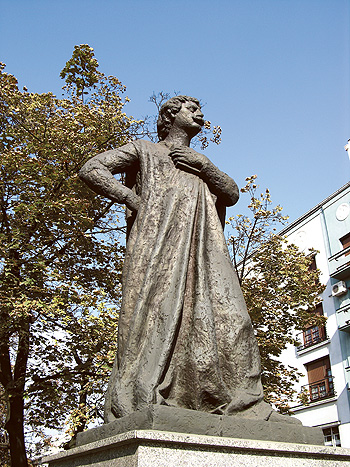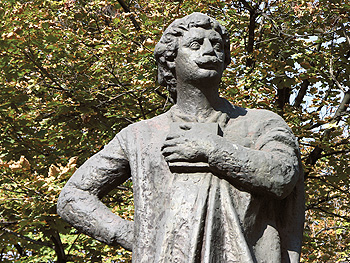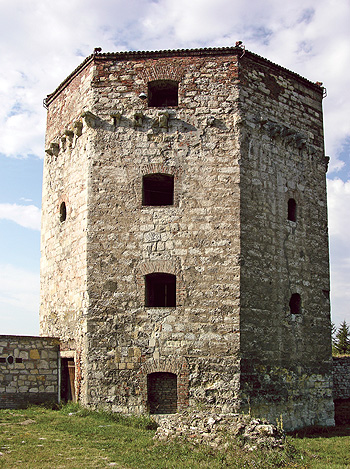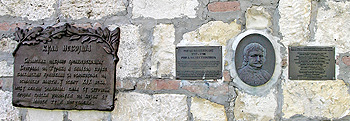Life, Novels RIGAS FERAIOS (1757–1798), FAMOUS GREEK REVOLUTIONARY AND POET, ENDED HIS LIFE IN THE WATERS OF THE BELGRADE CONFLUENCE EXACTLY 210 YEARS AGO
Burning Wish for Freedom
Rich and educated, he was only twenty when he was forced to kill some important Turkish figure in his homeland of Thessaly. After outrunning the pursuits, he first went to Olimp, then Mt. Athos, Constantinople, Bucharest, Craiova, Vienna... Inspired with revolutionary ideas and ideas about freedom, he believed in the joint liberation of Balkan Christians from Turkish slavery. He believed and did everything to achieve it. He was arrested by the Austrian police in Trieste and extradited to the Turks in Belgrade. His last words were: ”I have planted a rich seed. The moment is coming when my country will reap its glorious fruit”
By: Branislav Matić
 ”He first saw it before noon, on May 9, 1798, from the board of a ship which sailed from Vienna to Belgrade. The thirteenth day of sailing was beginning, and the ship was as unusual as its passengers were. Rigas Feraios stood on the deck already used to the chains around his arms and legs, as he has been wearing them for almost five months, and turned towards the winds that shed the softness of spring to the great river from their ancient homelands. He was not alone: as usual, three guards were around him. Rigas was standing, the guards were sitting. It was a well designed proportion: one prisoner and three guards, on that ship which carried eight prisoners from one empire, the Austro-Hungarian Monarchy, to another empire, the Turkish Empire. It was necessary that these prisoners travel safely, arrive safely, and then, also safely, be punished.” ”He first saw it before noon, on May 9, 1798, from the board of a ship which sailed from Vienna to Belgrade. The thirteenth day of sailing was beginning, and the ship was as unusual as its passengers were. Rigas Feraios stood on the deck already used to the chains around his arms and legs, as he has been wearing them for almost five months, and turned towards the winds that shed the softness of spring to the great river from their ancient homelands. He was not alone: as usual, three guards were around him. Rigas was standing, the guards were sitting. It was a well designed proportion: one prisoner and three guards, on that ship which carried eight prisoners from one empire, the Austro-Hungarian Monarchy, to another empire, the Turkish Empire. It was necessary that these prisoners travel safely, arrive safely, and then, also safely, be punished.”
That is how – according to the literary reconstruction of Svetlana Velmar-Janković – Rigas Feraios’ (1757–1798), the famous Greek revolutionary and poet with Tzintzar origins, and his seven co-fighters last journey and arrival to Belgrade looked like. The Austrian police arrested them six months earlier, in December 1797 in Trieste. They were passing through on their way from Vienna to Venice, where they were supposed to sail to their homeland, Greece, with the intention to, first there and then in the whole Balkans, organize a liberation uprising against the Turks. The voluminous Viennese investigation about the Balkan national liberation revolution that was being prepared lasted for almost half a year. Then the prisoners and all the findings were delivered to the Turks in Belgrade: the list of members of the ”conspirational association”, ideologists, helpers, money donators, the net of those who were waiting for them in Greece. Everything.
The Belgrade caimacam Osman-Pasha received the whole package in the early morning of May 9, ”personally delivered”. Eight chained men and chests with ”proof”. The prisoners, Greek patriots, extradited from a European and Christian empire to the Asian and Islamic one, were escorted from the dock to the Nebojša Tower.
Today we know that those gloomy armed guards with turbans on their heads and the rattling of chains, while they were walking the distance of about a hundred meters, were like the last escort on a funeral that was never to take place.
ESCAPE TO OLIMP Rigas was probably born in 1757, in the village of Velestino, Thessaly, exactly where ancient Pherae used to be. Those two names of his home place, from two eras and two worlds, will become part of his personal name. He presented himself and became famous as Rigas of Velestino and Rigas Feraios. He came from a rich Tzintzar family, a fact that members of that small Roman ethnos today proudly emphasize. He, however, considered himself a Greek patriot.
Due to the richness of his family, he was well educated. He was very young when he became a teacher in Kissos. Scarce and scattered chronicles do not mention details, but it is known that he was twenty when he entered into a conflict with some important Turk and killed him.
Honor? A woman? Unsubmissiveness?
 He outran the pursuits and found himself on the slopes of Olimp, where Spiro Zera accepted him in his military group. It is not known how much time he spent there. Probably soon, he went to Mt. Athos. Cosma, the prior of the Vatoped monastery, opens the doors for him. Then we find him in Constantinople where he was secretary to Phanariote Alexander Ypsilanti. He stands by the stone window turned towards the strait, looking into the distance; the verses he writes then still do not have that burning zeal by which he was remembered, but do not lack certain craft. He outran the pursuits and found himself on the slopes of Olimp, where Spiro Zera accepted him in his military group. It is not known how much time he spent there. Probably soon, he went to Mt. Athos. Cosma, the prior of the Vatoped monastery, opens the doors for him. Then we find him in Constantinople where he was secretary to Phanariote Alexander Ypsilanti. He stands by the stone window turned towards the strait, looking into the distance; the verses he writes then still do not have that burning zeal by which he was remembered, but do not lack certain craft.
Chronicles then register his presence in Bucharest: ”He returned to education, learned a few more languages, entered the service of the Walachian prince Nicholas Mavrogenes. When the First Russian-Turkish War began (1787–1792), he was in charge of inspecting the troops in Craiova. There he became close friends with a man he saved from Mavrogenes’ revenge, Osman Pazvantoglu, the Vidin pasha who rebelled against the Sultan...”
The lenses of the mentioned Serbian writer adjusted to literature see Rigas Feraios from those times like this:
”His knowledge was vast and various. He knew Greek, as well as Italian and German writers; he dealt with philosophy as well as geography, history as well as military tactics. Above all, music and poetry. He was a careful listener and brilliant orator, he knew both how to submit and how to lead. He was dangerous.”
At the time, Rigas Feraios learned about the ideas of the French revolution and became inspired by their national liberation potentials. On such basis, his dream about a joint uprising and the liberation of Orthodox nations from the Ottoman Empire came to life again. He was very proficient in gaining support of prominent people for his ideas. He met Greek bishops, rebellion leaders, members of some influential secret societies whose ideology and actions were woven both into the order of the world just being born, and into the life of Rigas Feraios himself. The spies of at least three imperial secret services reported that he often went to houses of French diplomats late at night, and during the day, after noon, held numerous meetings in the crowds of commercial quarters and at the Danube dock.
IN THE CENTER OF THE NET
 After the death of Prince Mavrogenes, Rigas Feraios worked in Bucharest for a while, officially as a translator in the French Consulate. It seems that already at that time, his secret revolutionary and national liberation society ”Philiki Heteria”, had many very capable members, organized in concentric circles and nets. After the death of Prince Mavrogenes, Rigas Feraios worked in Bucharest for a while, officially as a translator in the French Consulate. It seems that already at that time, his secret revolutionary and national liberation society ”Philiki Heteria”, had many very capable members, organized in concentric circles and nets.
However, there was a lot to be prepared before starting an armed uprising. Several sources state that Rigas Feraios, although under multiple surveillance, calmly packs his things and in 1793 travels from Bucharest to Vienna ((I. C. Bolonachi: Hommes illustres de la Gréce moderne, Paris 1875; E. M. Edmonds: Rhigas Pheraios, London 1890; Rizos Neroulos: Histoire de la révolution grecque, Paris 1829). Vienna was a place where a large Greek colony lived, where the ideological propaganda, financial, logistics and political preparation of the uprising was to be completed. A question remains until today: did Rigas Feraios truly believe that the national liberation aims of the Greek and other Balkan Christian nations concurred with the strategic interests of all three poles of the then Europe – with revolutionary France, with Austro-Hungary, with Russia? Or, however, as others suggest, did he synchronize his activities with only one of them (revolutionary France)?
It is certain, however, that he developed strong activities in Vienna.
”He was editor of the Greek Ephemeris. He designed and printed the program map of Great Greece (Harta), which also included Constantinople. He made a draft of the constitution of free Greece. He published many pamphlets which ‘spread like fire’: ‘Declaration on the Rights of a Human and Citizen’, ‘New Political Constitution’, ‘Inhabitants of Rumelia’, ‘Asia Minor’, ‘Aegean Islands’, ‘Principality of Walachia and Moldavia’...”
Better to live one hour as a free man, than forty years like a slave! cries Rigas Fereios in his famous poem Thourio.
Greek sons, rise! he sings in his Greek version of the Marseillaise, which Byron quoted and made even more famous.
In his Martial Poem written in Vienna in 1796, intended for the Balkan Christians, Rigas encourages:
Start a flame throughout Turkey,
To enclose all, from Bosnia to Arabia!
Already the following year, as stated by Vladimir Ćorović, this song was sang in Zemun. It arrived to the confluence of the Sava and the Danube one year before its author.
SILK CORD, AT DAWN
The legend says that Rigas Feraios first sent Napoleon one cigarette case made of laurel root from Apolo’s temple. (A gift? A code?) Then they began their correspondence. The contents of the correspondence, if we exclude some unreal and some too mellifluous interpretations, remain unknown.
However, the already mentioned assumption seems probable – in December 1797, Rigas Feraios was traveling via Trieste to Venice, which was already a strong center of French revolutionary propaganda, where he was supposed to meet Napoleon (for the first time?), and from there continue his trip by ship towards the south, to the Greek Ionian coast. Shortly before Rigas, several chests with printed proclamations about beginning the Greek uprising were sent the same way, which, instead of reaching their destination, reached the hands of Austrian police.
 It seems that, despite of different romantic convictions, Napoleon was the only one at the time, among all European political powers, who was ready to truly support the liberation movements of the Balkan nations, also not from romantic or liberation reasons, but only because the powers that stood behind him considered convenient anything leading to destabilization and mutual exhaustion of ”conservative European empires”. It seems that, despite of different romantic convictions, Napoleon was the only one at the time, among all European political powers, who was ready to truly support the liberation movements of the Balkan nations, also not from romantic or liberation reasons, but only because the powers that stood behind him considered convenient anything leading to destabilization and mutual exhaustion of ”conservative European empires”.
In any case, that December day in Trieste was mild and filled with winter lights of the Mediterranean. Rigas Feraios stood at the square, and the concentric circles which had been spreading from him towards the world for years now had an opposite direction. They were returning and tightening around him. And they did not consist of his associates, but of discrete agents of the Austrian police. In both cases, he was the center of that net.
”The arrest took place without noise, without threatening, almost politely. Worried about the ideas of the French revolution, the Austrian authorities performed it, this time as an ally of the Ottoman Empire.”
Sources state that Rigas Feraios tried to commit suicide immediately after the arrest, but he was prevented in doing so. We do not know how. All the rest we know. Mainly all.
Before noon on May 9, 1798, the ship approached Zemun”, writes Svetlana Velmar- Janković. ”From the prow, Rigas Feraios saw the spaces of the enormous old sky, calmed in the lights arriving from the very abysses. Without moving, this sky stood, eternally, above the waters, above the valley, above the glow of the day; it stood above the city that, on a steep height, persistent in its whiteness, dwelled under centuries.”
Imprisoned in the Nebojša Tower together with his seven closest co-fighters, Rigas Feraios spent forty-six days in chains. Apocryphal chronicles say that at the time, sometimes, deep in the night, a shockingly sad song used to be heard above the Confluence, in a language neither Turkish nor Serbian, and that it was interrupted with cries, probably because of blows.
Rigas Feraios and his seven friends were supposed to be sent to Constantinople from Belgrade, to the Sultan to determine their punishment. However, someone from the top of Belgrade Turks did not like the idea. Were they afraid of the Sultan’s ”soft verdict” or really, as some state, of the possibility that Rigas could be liberated by his friend Osman Pazvantoglu? Or they simply ”wanted to take a shortcut”?
It is not completely known how Rigas Feraios and his co-fighters ended their lives in the Belgrade Nebojša Tower. There are several versions.
”It is most probable, however”, writes Svetlana Velmar-Janković, ”that they were strangled in the dungeons, the Turkish way, with silk cords, at dawn. They threw their bodies into the river, so the Turkish authorities could later rightfully say that Rigas Feraios was no longer in Belgrade since they had recently transferred him further, down the Danube.”
*** Nebojša
The name of the famous Kalemegdan tower is derived from the negation of the verb to fear (Serb. ne bojati se). In the time of Despot Stefan, it was, according to some interpretations, a donjon tower. The original names of the tower were White and Timisoara Tower, while it got its present name in the XVII century. In an explosion of gunpowder during the Austrian and Turkish battles, Small and Despot’s Town were blown up together with the original Nebojša Tower, whose name was later given to the tower in the dock.
*** Memorial or Café
There have been several attempts through the Belgrade City Assembly to open a café in the Nebojša Tower, that horrible scaffold and valuable monument of the Serbian history. Protesting, the Greeks were ready to invest several millions of Euros and make the Rigas Feraios memorial center there, but final approval has never been made. So, the last preserved remain of the medieval city of Despot Stefan is marginalized and unarranged, still waiting for responsible decisions and real solutions.
|
